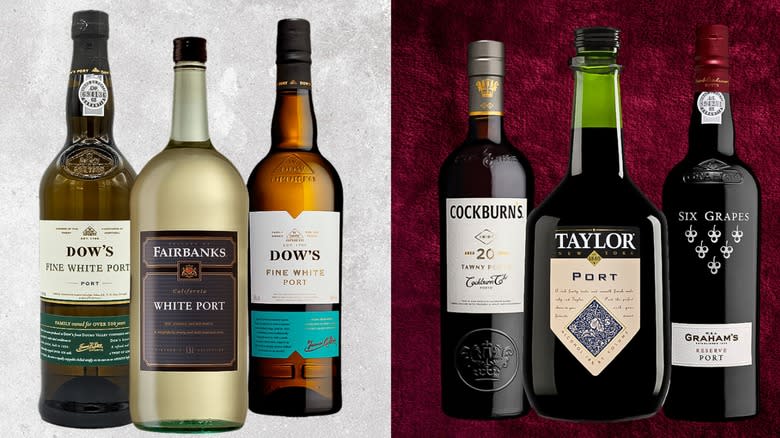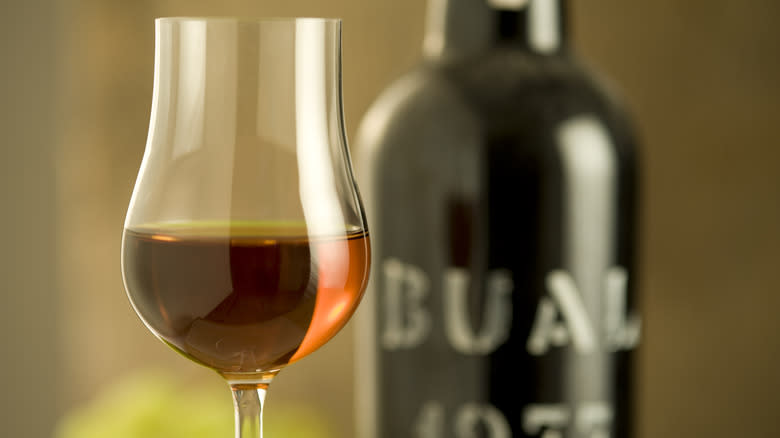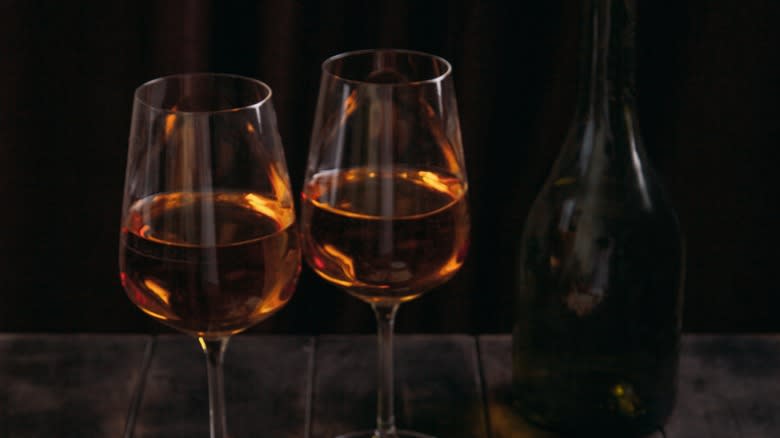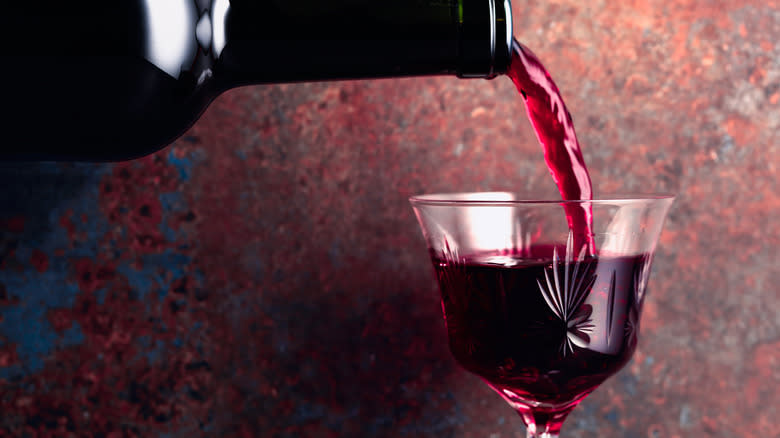White Vs Red Port: What's The Difference In Flavor Profiles?

Sweet, fortified wine that's rich and high in both sugar and alcohol — talk about a mouthful (in a good way). Fans call it port, and there's a reason it has withstood the seemingly-ever-changing tide of wine trends and remained a fortified fixture for centuries.
To make port wine, a clear, neutral, grape-based spirit (often brandy, not unlike Madeira wine) is added to wine during the fermentation process. The addition of the distillate increases the wine's natural sugar content and stops fermentation. Because the brandy is high in alcohol (roughly 77% ABV), it kills the active yeast, resulting in younger batches that clock in between 16 and 20% ABV. Per the lore, the creation of port was likely a happy accident, as savvy winemakers from the late-1600s learned that adding aguardiente or brandy could rescue over-fermented batches of wine, making them palatable again.
There are four primary types of port -- red, white, rosé, and aged Tawny -- but today, we're deep-diving into the red and white varieties to help discerning sippers direct their sails toward a glass they'll love. Both are all about a sweet, accessible, dimensional flavor and lively mouthfeel, but that's about as far as their similarities go. Generally speaking, white ports are lighter and more acidic than reds while the latter ports taste fruitier and spicier.
Read more: 13 Liquors Your Home Bar Should Have
What Is Red Port?

Genuine port wine is protected by a PDO designation of origin, and can only be produced in Portugal. In the country's world-famous Douro Valley, in the northern provinces not far from the Atlantic Ocean, roughly 50% of vineyard land is used to grow grapes that will become port. (Pro tip: If the wine label says "Porto," "Oporto," or "Vinho do Porto," it was produced in Portugal. If it just says "port," it was probably made elsewhere.)
Red port (aka ruby port) is young and accessible yet with a weighty palate. Ruby ports are typically aged for fewer than three years in concrete or stainless steel after fermentation. These materials prevent oxidation, keeping the wine bright, young, clean, and immature on the palate. Approximately 80 different grape varieties can be used in red port, and just shy of 50 varieties are permitted in white port. Red port grapes typically include the "big five" varieties, which are Touriga Nacional (robust and tannic, high structure), Touriga Franca (fruity and floral), Tinta Barroca (jammy), Tinta Roriz (deep red hue), and Tinto Cao (spice).
What Is White Port?

White port is fruity, full-bodied, and more acidic than its red counterpart. It's commonly made from the Portuguese indigenous grape varieties Malvasia Fina (molasses and nutmeg), Gouveio (apple-y flavor), Viosinho (intense aroma and full-bodied structure), Rabigato (bright acidity), Moscatel Galego Bronco (orange and apricot), and Códega do Larinho (higher ABV). If you spot the "colheita" label on a bottle of white port, that means the wine was made from a single-year vintage, and likely comes with a higher price tag to match.
White port is made by only about 30 small-batch producers in Portugal's Douro Valley. During the production process, white port also has a shorter maceration period that red port. Maceration is the step during which the seeds and skins are left in contact with the grape juice. The resulting flavor of white port can range from dry (Seco) to hyper-sweet (Lagrima). Lagrima is Portuguese for "tears," a reference to the visible legs that appear on the inside of the glass after a swirl from the wine's high viscosity. Still, smoothness and lively acidity are a common undercurrent of white port regardless of sweetness or dryness.
Red Port Is Fruity And Spiced

Fans might be more familiar with red port than white. Red port features top tasting notes of red berries (especially raspberries and blackberries), caramel, cinnamon, and chocolate. These flavors come together for an ultra dessert-like profile while still bringing some dimensionality to the table, not getting lost in the sweetness.
The bright red to violet hue is dominantly influenced by plums, cassis, cherry, blueberry, and overripe red berries. However, some red ports tread on the darker side, characterized by notes of plum and woodiness plus licorice, clove, and anise for a spiced bite. Whichever way they lean, red ports are best served slightly chilled to around 60 degrees Fahrenheit. Word to the wise: Port wine, which boasts rich sweetness and a high ABV, has a serving size of 3 ounces as opposed to "regular" wine's 5-ounce standard pour. (Although, for optimal tasting, 3 to 4 ounces of wine per glass is a better move.)
White Port Is Bright, Acidic, And Stoney

By contrast, white port is all about lift -- and as a general rule, it's younger, brighter, and lighter than the red stuff. The former features top tasting notes of stone fruit, citrus peel, and nuts. Its golden hue and honey-nut aroma are rounded out by a sharp citrus back end. The first sip of white port may bring apricot, citrus peel, baked apples, and roasted nuts, followed by toffee, orange, apple, and honey. Aged white ports boast vanilla, almond, and oregano notes.
White port packs higher acidity and a dry taste with a bit of sweetness, a very complex interplay. Some varieties can be quite sweet. Leve Seco is the driest variety of white port (16% ABV and oak-aged for five to 10 years), followed by medium-sweet White Porto (deeper color and aged for three or more years) and the sweetest, perhaps best-known Lágrima white port. White port is best served cold, within the 42-50 degree Fahrenheit range.
Different Food Pairings For Different Flavors

Red ports are traditionally served as digestifs or replacements for dessert while white ports work well as chilled aperitifs pre-dinner. Particularly voracious port-lovers might even serve both as the warm-up and grand finale to a proper meal. Luckily, red and white ports work for both sweet and savory food pairings. It's all about showcasing their idiosyncratic tasting profiles.
Pair red port with a charcuterie board of bold cheeses like Stilton or Roquefort, smoked nuts, cured meats, and chocolates. For savory, go with veal chops. For a knockout dessert spread, red port complements dark chocolate truffles, pecan pie, and cheesecake. Croft Fine Ruby is a classic red port: fruity, spiced, and sweet. Graham's Six Grapes Reserve Ruby leans deeper with dark chocolate, plum, cherry, and a long, lingering finish.
Pair white port with hard, nutty cheeses, salted almonds, and fresh stone fruits like peaches and plums. For dessert, it'd go well with sponge cake, coconut macaroons, and meringue. Or, bring white port into entree territory alongside richer seafood dishes like clam chowder, lobster bisque, salmon crudo, or whole roasted fish. A bold, rich, nutty, dry white port by Quinta do Infantado packs light skin contact and medium-high acidity. For a more confectionery sipper, Van Zellers has intense honey, raisin, maple, and almond notes.
Read the original article on Tasting Table

 Yahoo Lifestyle
Yahoo Lifestyle 
